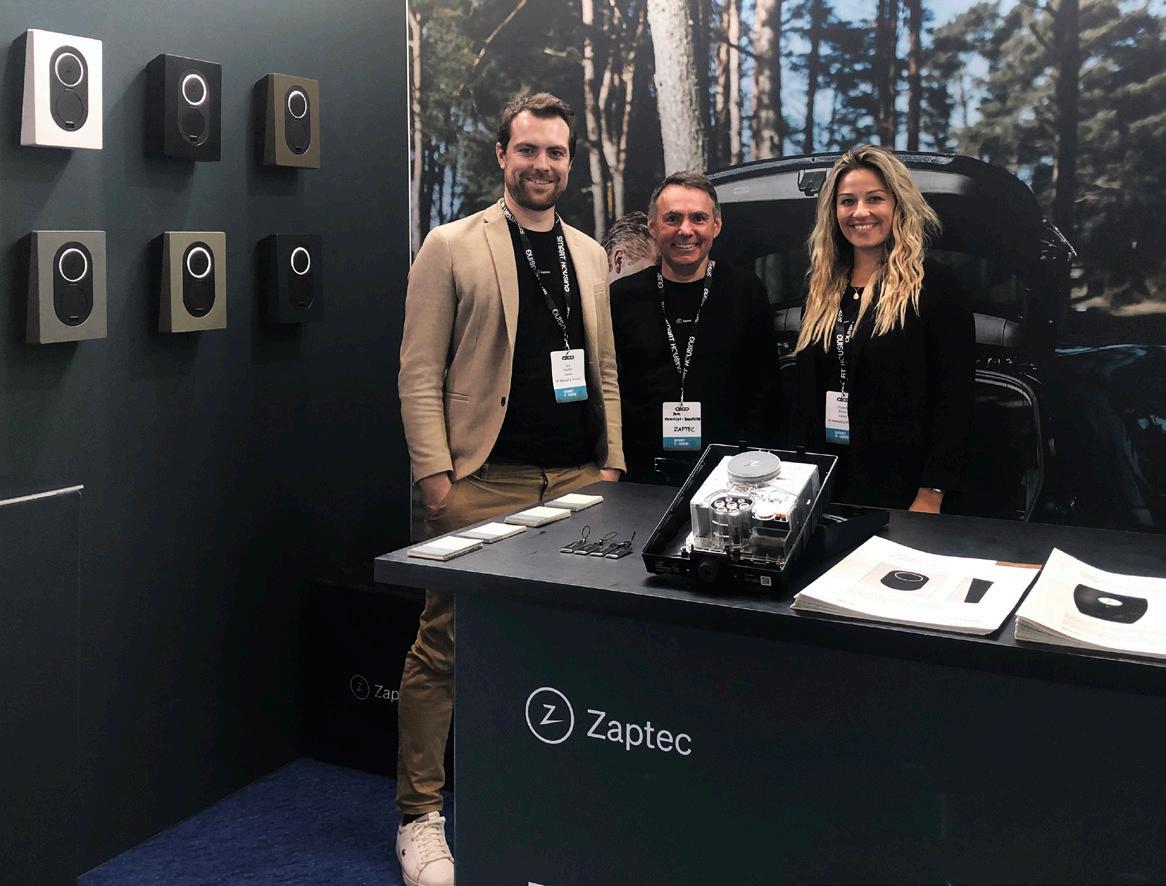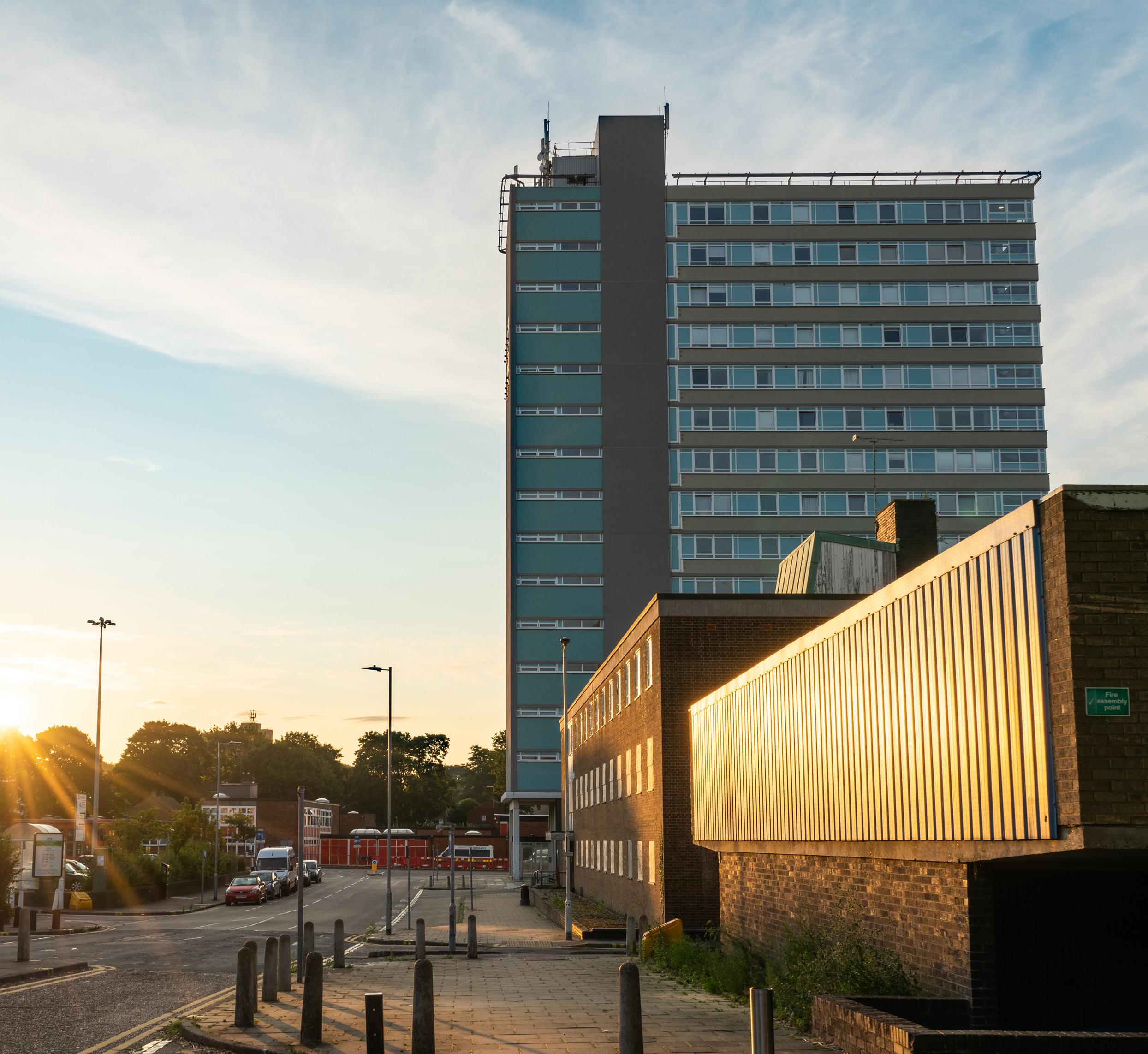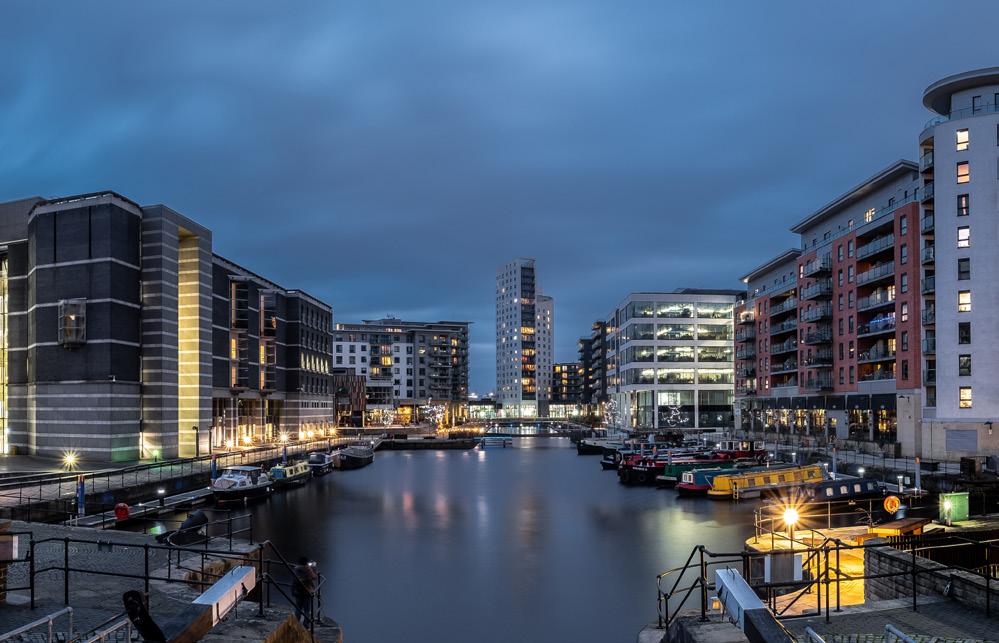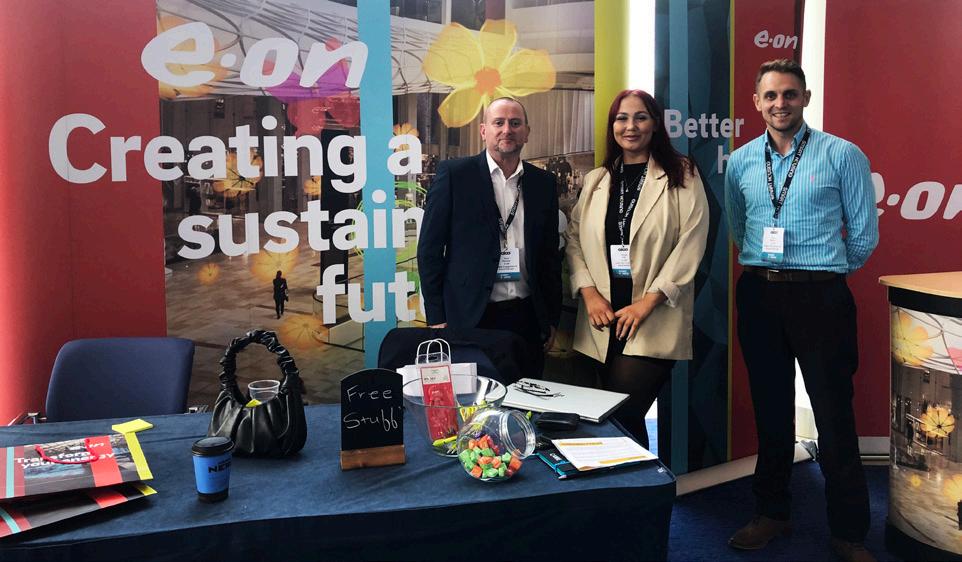

What did Smart Housing North West Uncover?
Networking with like-minded people is the best way to improve the sector.
As the DLUHC announced a whole wave of new funding opportunities for the social housing sector, Quadrant Housing explores the requirements for funding and the potential to revolutionise the housing sector.


In this issue, Quadrant Housing analyses how the sector can make the best use of new and existing technology to meet the changing landscape of the housing sector, what was explored in the Smart Housing North West panel debate, and how a retrofit revolution can create two million jobs.
With a specific focus on how the social housing sector can expand its housing stock faster, Quadrant Housing dives into the most topical discussions and debates about the future of the housing industry.
Floyd Marchquadrant-smart.comf.march@peloton-events.co.uk


6th Round of the Local Digital Fund now Open
The Local Digital team of the Department for Levelling Up, Housing and Communities (DLUHC) has announced the latest competition for funding for projects led by local authorities. As this is the sixth round, what has happened so far and what is yet to be announced?
The DLUHC is preparing to delegate £2.5 million of funding through the 6th round of the Local Digital Fund. In an attempt to make services safer, more resilient and more cost-effective, digital platforms may be in the alpha, beta or discovery phase.
Digital solutions can range from complex systems, large-scale infrastructure, or more niche focussed solutions for more minor services or issues. In order to engage with the supply chain, the DLUHC will be hosting a webinar on 19 October 2022 and will publish a fund prospectus with complete assessment criteria.
Focusing on a wide scale of topics for one fund draws controversy around whether funding matches the needs of the housing sector. Naturally, there will be a balance of public and private funding for all forms of innovation, but some argue that more public investment at the start of innovation projects will be followed up by further private investment and final investment decisions.
Applications will be open from 19 October until 24 November 2022. Following on, they’ll conduct an interview process in early December, with winners announced in early 2023.
Lawrence Hopper, deputy director for digital at DLUHC, commented: “The same things apply in helping councils to deliver the Local Digital Declaration,
councils creating services that meet user needs and making services safer, more resilient, cheaper to run and breaking the dependence on expensive and flexible technology.”
“This time around, we can afford to be bolder. Many projects we’ve funded have been successful, and we’re not just trying to seed fund new activity as there is a lot of good activity out there. We want to be bolder in tackling the big service domains such as housing and revs and bens.”
While it is essential to focus on digitalising the social housing sector, it is also important that the cyber security of these assets improve in line with the adoption of new technologies. If the sector fails to address these concerns, we will likely see increased cyber attacks against authorities and associations.
“The funding we have allows us to do so, and it’s becoming more mainstream in the sector to collaborate.”
He added that the projects to receive backing would involve collaboration between councils and “have a reasonably clear route to scaling solutions”, with a strategic benefit to the whole sector.
In the 5th round of the funding, £2.37m was awarded to eight projects to improve the sector’s digitalisation effort. An increase in funding for the 6th round offers some optimism surrounding the DLUHCs commitment to the Local Digital Fund.
T his time around, we can afford to be bolder. Many projects we’ve funded have been successful, and we’re not just trying to seed fund new activity as there is a lot of good activity out there. We want to be bolder in tackling the big service domains such as housing and revs and bens.
 Lawrence Hopper
DLUHC
Lawrence Hopper
DLUHC
Developing Derelict Buildings into Smart Living Communities
After Aitch won consent for the 65home Poplar scheme, how essential is it to make the best use of land that has already been developed?
Making the best use of brownfield land is one of the ways urban areas can both regenerate the local community and provide housing for people looking to move from rural to urban areas.
In this case, the 65-home residential block will replace a derelict community centre on the edge of a conservation area in Poplar, East London. Approving the 5,100sq m scheme, Tower Hamlets Councillors voted unanimously to approve the project.
With the community centre being vacant for over a decade, the council decided to make better use of valuable urban spaces and provide housing for 65 residents. Vacant buildings are a growing concern across the UK, with 617,527 empty buildings across the UK, of which 172,217 were commercial buildings as of 2019. This figure is likely to be higher now.
The application had received 76 letters in support and four against, with the objectors arguing the six-storey scheme was too tall and that its design would clash with the surrounding Victorian and Georgian buildings.
Those in support explained that it would rid locals of a long-vacant site which was regarded as an eyesore and provide much-needed high-quality housing.
With overwhelming support from the public and the council, the sector hopes to take advantage of the changing attitudes around building new properties on brownfield land.
While there has been a lot of support for the project, there have been calls for more of the housing development to be made available for social housing residents. As it stands, only 11 properties will be made affordable.
The site is also located close to Erno Goldfinger’s grade II*-listed Balfron Tower, part of the 1960s Brownfield Estate, which also contains Goldfinger’s Glenkerry House and Carradale House, both grade II-listed.

The officer’s report added that considerations were: “properly incorporated into the design process to ensure that the proposals compliment the local setting, rather than try to replicate the design of local buildings and otherwise create a pastiche.”
This is a delicate issue for many local authorities as balancing new developments and keeping the area's aesthetic is extremely difficult. However, if the industry is to reduce the impacts of the housing crisis, there will need to be some compromise.
W ith overwhelming support from the public and the council; the sector hopes to take advantage of the changing attitudes around building new properties on brownfield land.

New Digital System for Social Housing to go Live
The Department for Levelling Up, Housing and Communities (DLUHC) is moving towards the go live of a new digital system for data to revolutionise social housing.
The DLUHC recently agreed on a £9 million contract with customer software developer Softwire Technology to help launch the platform and develop a data collection team inside the department. The contract will run up until July 2024.
Replacing the existing CORE service, the new platform will better allow for lettings officers and managers in local authorities and housing associations to share the appropriate information necessary.
The contract notice explains the system will also be used by statisticians and analysts, along with staff providing support to the organisations that supply the data.
A DLUHC announcement in early 2022 outlined the complexity of the project, saying it was utilising JSON schema and front end libraries. In a statement, the DLUHC explained it is: “Looking at reducing the burden of data submission to central government through usercentred design and automation.”
The new service will allow users - in this case housing officers and their managers in local authorities and housing associations –to share data on new social housing lettings and sales by:
• Logging individual instances of lettings and sales by answering questions
• Uploading data about multiple sales and lettings using a CSV template
• Transferring data via API
The information shared by these organisations makes up a set of National Statistics, which need to meet a high standard of trustworthiness, quality and value.
Explaining how the DLUHC are looking to improve the way the housing sector uses data, they explained: “For now, we’re working on the first submission method. We have an early draft of the API specification, and we’re getting to the bulk upload next, but we needed to prioritise the user needs of less digitally mature organisations to ensure we’re delivering a data submission service that everyone can use.”
From a design perspective, this service presents some unique challenges because, unlike mainstream citizen-facing services that are used once and provide something in return, users of this service are professional daily or weekly users, and their need is simply to get their job done.
We've used DfE's frontend libraries, including its formbuilding components, as our source code and built a more bespoke form builder/runner on top. We've also worked with DfE to improve things for anyone else wanting to use the code.
Continuing the statement said: “But that doesn’t mean design needs to take a back seat! To help users do their jobs quicker and better, we’ve been experimenting with GOV.UK’s Task List pattern and the one-thing-per-page design principle, to replace the long online “form” with all the questions on one page.”
From a tech perspective, the DLUHC has seemed to move from document / paper-form-based data collections to being (JSON) schema-led. This means the online log submission user interface is now auto-generated. Other formats, such as a printable form, a bulk upload template and the API spec could be auto-generated in future, rather than manually built from a legacy paper form.
The aspiration is for a much more efficient and flexible way to build and maintain a data collection service.

Smart Housing NW: Insights Into the Sector
At Quadrant Smart’s latest regional housing event, industry leaders came together to discuss how technology and innovation are essential for net zero, retrofitting and resident engagement.
The second panel debate of the day allowed the audience to interact with industry leaders from the housing sector.
For this debate, the host, Floyd March, was joined by Sam Collier from Aico, Andrew Hunt from Oldham Council and Ben Dawes from CAME Entrotec to discuss the role of 5G in the sector, the core role of scalability and the importance of resident engagement.
For several years, the social housing sector has discussed the use of smart technology and its benefits. However, outlined in the ‘Internet of Things and Smart Controls in Social Housing: Market Intelligence’ report from 2020, it was revealed that only 56 per cent of social housing organisations surveyed had either implemented or trialled IoT solutions.
Addressing this issue, the panel began with presentations from Aico, Oldham Council and CAME Entrotec to highlight how they are implementing technology solutions to the housing sector.
5G isn’t always as necessary as we think, but lots of excitement surrounds it
When asked how 5G will help with their products, Sam explained: “At the moment, we use a 2G roaming SIM, which we are currently looking to upgrade to a 4G roaming SIM with our gateway. The model we work towards keeps the system at a low cost while maximising the quality of the product. Regarding data back to the cloud, we don’t have the requirements that 5G specifically facilitates, so it would
be an increased cost with little impact on the residents."
He went on to tell the audience: “For example, our environmental sensors take readings every 15 minutes, but the data isn’t actually sent back to the cloud until every 2 hours.”
Moving on, Ben from CAME Entrotec said: “At the moment, we connect through hardware to other people’s CCTV where we send out the alerts, so we use a lot less data. With the current data, we are still able to record the data every 2-3 minutes of scanning the fob.”
Talking more widely about 5G and the impact it’ll have on the social housing sector, Ben informed authoirites and associations that are looking to implement technology into their housing stock: “5G will help unlock new possibilities of realtime CCTV streaming for limited periods, directly to the cloud if needed.”
Andrew expanded on this: “One of the biggest advantages of our RED WoLF system is that it can cope really well with the current bandwidth of 3 and 4G. Obviously, as 5G advances, technologies around it will evolve, so it is a really exciting time for local authorities such as Oldham Council.”
Before the session moved onto the scalability of services across the sector, Ben explained how a future-proofed approach to technology is an essential aspect of developing the sector: “The biggest change will be the access controls transitioning away from the old analogue lines, which we haven’t supported for over six years. We’ve been using the 4G SIM cards for the last six years because we know the two and 3G networks will be phased out at some stage. We do this to future-proof our projects.”
Technology must be scalable and designed for the residents
In the second half of the panel debate, a member of the audience asked how important it is to plan for projects with scalability in mind from the initial outset.

Covering off the question, Andrew began by stating: “Once the pilots are complete, the next stage of the project will be the commercialisation of the system. So, one of the objectives of the projects is to scale to 150,000 systems over the next decade.”



Expanding on this, Sam added: “There’s a massive need and opportunity in the social housing sector to scale up our technology. One of our strategies is to develop a product that’s extremely cost-effective but easy to scale. So, there are technologies that we have not implemented because we want to monitor things in the property with as little cost as possible to get the maximum impact on the resident and the maximum impact on the sector as it is easily scaled.
As the audience’s questions continued, the panel discussed vital topics such as resident engagement, GDPR and product and project specifics.
W
e are looking at the ways in which we can make the market development plan streamlined and effective. We are looking for future revenue streams, including Innovate UK, BEIS and also private sector funding.
Andrew Hunt Oldham Council
UK Government to Take Dangerous Freeholders to Court
With the UK Government taking legal action against a freeholder failing to fix building safety defects, what message will this send to the rest of the sector?
Grey GR Limited Partnership, the freeholder of Vista Tower in Stevenage, has been given three weeks to take action or face the courts by the DLUHC.
This comes on the back of a promise of the Building Safety Act that the government will take legal action against freeholders failing to fix building safety defects.
Holding freeholders to account sends a strong message
Over 100 leaseholders of Vista Tower, a fifteen-story tower block in Stevenage, have been handed extortionate bills and left unable to sell. This comes after unsafe cladding was identified on the building over two years ago.
Determined to stop the fees and bills being passed onto leaseholders living in unsafe accommodation, the freeholder is one of the first to face action by the Recovery Strategy Unit.
The unit was created to identify and pursue firms who repeatedly refuse to fix buildings and has worked closely with enforcement authorities to ensure the safety of residents across the UK.
Levelling Up secretary of state Simon Clarke said: “The lives of over 100 people living in Vista Tower have been put on hold for over two years whilst they wait for Grey GR to remediate unsafe cladding. Enough is enough.”
Continuing, Simon Clarke explained: “This legal action should act as a warning to the rest of industry’s outliers – big and small.
Step up, follow your peers and make safe the buildings you own, or legal action will be taken against you.”
DLUHC
The DLUHC is considering implementing further penalties
Whilst the building registered with the Building Safety Fund in 2020, the funding agreement is yet to be signed, meaning the government cannot release any money.
There are at least 23 other buildings registered with the Building Safety Fund that have been unable to progress due to unnecessary delays. The department is examining these cases closely and considering the next steps.
The Secretary of State will also consider issuing an application for a Remediation Contribution Order against other entities associated with Grey GR.
With the intention of deterring other companies from associating with unsafe building practices, companies, including Railways Pension Trustee Company Limited (RailPen) and Railtrust Holdings Limited (Railtrust), may also be held responsible for financially contributing to the remediation costs.
T his legal action should act as a warning to the rest of the industry’s outliers – big and small. Step up, follow your peers and make the buildings you own safe, or legal action will be taken against you.
Leaseholders are now able to apply for a remedial order
Leaseholders can apply to the Property Chamber of the First-tier Tribunal for a remediation order if their building has historic fire safety defects, has been assessed and needs to be remediated, but the work has not yet commenced.
The DLUHC explained on their website: “If the work does not begin within the timeframe the First-tier Tribunal states in their judgment filing of a remediation order, then the decision can then be filed with and enforced as if it was an order of the county court.”

You can apply for a remediation contribution order to recover the costs you had already paid towards remediation before the leaseholder protections came into force.
DLUHC
IPPR: Retrofit Revolution can Create two Million Jobs
Arecent report published by the IPPR named ‘Plan for a retrofit revolution: how more than two million new jobs would boost levelling-up and also tackle energy crisis sets out a £7bn a year plan to retrofit the UK social housing stock’ highlights how we can best retrofit our existing housing stock.
The core themes of the report explored the notion that areas in need of levellingup would benefit twice as much from nationwide retrofitting schemes as London. Additionally, the report highlights how a £7bn a year scheme would sustain 2.7 million direct and indirect jobs to 2050, helping growth and net zero.
Retrofitting England’s homes with good insulation and new heat pumps is a ‘nobrainer’ to create jobs, boost growth, reduce energy bills, level up and also meet our net-zero target, according to a new report by progressive think tank IPPR.
Around 24 million homes need some form of upgrade
Almost all of England’s 24 million homes need to be upgraded, putting us far behind European neighbours like Germany and France. On top of this, new build homes are currently being built that will need retrofitting before 2050.
Additionally, the sector is currently installing less than 10 per cent of the measures needed in our existing housing stock across the social housing sector and privately rented/owned homes. Wider implications of this include higher bills and increased burdens on the NHS through cold and damp homes.
Working on ways to improve the standard of existing and new build properties across the UK, the IPPR has laid out a 28-year plan to retrofit every household in England, which at its core would create 1.2 million direct jobs and 1.5 million indirect jobs. It would also provide a cornerstone for the levelling-up agenda, as well as reducing households’ bills by an average of £430 a year, according to the report.
Highlighting these concerns, the report identifies: “There is currently significant regional variation in employment opportunities. A retrofitting programme, at the cost of £7bn a year, would benefit regions such as the North East and the West Midlands more than twice as much as areas like London and the South East."
Continuing, it explained: “The plan would create over 61,200 new direct retrofitting jobs in the North East, equivalent to more than 5 per cent of the total job market in the region, whereas for London retrofitting jobs would represent slightly over 2 per cent of total employment.”
Looking at the areas that will benefit the most from this type of scheme, coastal constituencies like Clacton, Wallasey, and South East Cornwall would benefit the most, along with former industrial centres like Doncaster North and Sheffield Hallam.
Five key policies UK Government should consider
The report makes five key recommendations for the government to make substantial progress:
Standards | Set a clear direction for the market and introduce stricter EPC minimum standards, and decide on a phase-out date banning the sale of oil and gas boilers.
Skills | Expand training standards to invest in skills and clamp down on bad practices such as ‘pay to pass’ training.
Funding | Introduce a comprehensive ‘one-stop shop’ for financial support known as the GreenGo scheme, which would include full grants for fuel-poor homes and substantial grants and zerointerest loans for other groups.
Communication | Launch a massive national information campaign and a properly resourced advice service.
Local capacity | Increase funding to local authorities to deliver retrofitting schemes tailored to their areas.

Luke Murphy, head of the Fair Transition Unit and associate director for the energy, climate, housing and infrastructure team at IPPR, said: “The new prime minister and chancellor have said they want to focus on growth. This report shows that a national retrofit programme can deliver jobs and growth right across the country and deliver levelling up at the same time. It would also lower energy bills, reduce energy demand and our dependence on Putin, and lessen carbon emissions.”
Joshua Emden, the IPPR senior research fellow, said: “The UK is in the middle of the worst energy bill crisis for at least 50 years. The price cap freeze shields us from absolute catastrophe, but many households are already struggling with last April’s increases. It is vital that the government takes steps to make us less vulnerable in future."
Rounding up, Joshua explained: “Retrofitting will not just play a crucial part by cutting energy consumption, but also has the capacity to level up the regions most in need. Over a million direct jobs, and more than a million more indirect jobs, would be created if the government pursued this retrofitting plan. Left-behind areas like former industrial centres and coastal communities would benefit the most from these jobs and the economic growth they will bring. The country would be better off, the economy would be better off, and the climate would be better off.”
North
61,280
116,806
South
134,151 4.32%
145,627
169,521
hard to think of another intervention that could deliver on so many objectives at the same time. It’s time the government acted and invested in upgrading our nation’s homes, making them warmer and more affordable. It’s a no-brainer.
Expression of Interest in Hosting Investment Zones Applications Open
As Liz Truss announced that Upper-tier local authorities can now lodge an expression of interest in hosting investment zones, Quadrant Housing highlights how this is aimed at boosting development through reduced regulation and simplified planning.
The DLUHC opened the bidding process for the zones, which was originally announced in last month’s controversial mini-budget.
Investment Zones currently targeted at combined and Upper-tier authorities
Applications are welcomed from combined mayoral authorities, upper-tier councils and freeports. Expressions of interest are open until 14 October.
In order to cut red tape, the zones will operate under a simplified planning process, reduced taxation and lower regulations and are intended to stimulate or speed up the development of residential and commercial sites.
The DLUHC provided 24 illustrative examples of where sites could be selected, including Blackpool airport, various sites in the Black Country and the River Hull corridor.

Criteria can be found on the DLUHC site
Guidance published yesterday explained bids will be assessed by criteria based on ‘economic opportunity, the pace of delivery and wider strategic alignment.’
The guidance sets out a series of questions that authorities will need to follow to be selected for the project.
The DLUHC opened the bidding process for the zones, which was originally announced in last month’s controversial mini-budget.
It said residential sites will: “Need to demonstrate housing impact through acceleration or additionality.” On top of this, commercial sites will need to highlight how the zone will “drive the development of at present undeveloped land and/or fulfilment of growth potential.”
Authorities have until 14 October to submit an expression of interest. DLUHC said it would then work with authorities on their delivery plans and confirm sites represent value for money and deliver housing and growth objectives.
Investment zones don’t come without controversy
The investment zone plan has drawn criticism from some in the industry who argue planning reforms should be applied everywhere and not in selected regions. Others raised questions about additionality, highlighting many of the zones will already have the principle of development established.
Questions remain about whether these investment zones will be awarded for social housing to be built as wider housing policies that adhere to ‘strategic alignment’ are currently unclear.
Despite this, if these investment zones aren’t suitable for social housing, wider policy should look at implementing similar zones with simplified planning processes and lower taxation, specifically in the social housing sector.

DLUHC provided
illustrative
of where sites could be selected, including Blackpool airport, various sites in the Black Country and the River Hull corridor.
How is Yorkshire Delivering for its Residents?
Building on the success of Smart Housing North West, Quadrant Smart will be coming to Leeds on 21 February 2023 to discuss the core issues and opportunities in the area.
As Yorkshire covers a vast area, including rural, suburban and urban areas, the region has a range of challenges to overcome in the housing sector. These range from net zero, retrofitting, improving cyber security and promoting regional innovation.
To tackle these objectives, Leeds City Council launched its Housing Strategy 2022-27, named Best City Ambition. Offering a whole range of opportunities, the strategy includes plans to deliver 928 mixed-tenure homes starting with an initial 311 energy-efficient affordable homes. This will build on the 54,000 council-owned dwellings currently in Leeds.
Deliverability is a core aspect of Leeds’ strategy
Responsible for roughly 2.2 per cent of England’s housing supply in 2021, Leeds has delivered 16,249 homes over the last five years. The strategy hopes to expand on these deliverability statistics and offer a framework for smaller authorities to implement similar projects.

The strategy also highlights the essential factor that the housing sector contributed roughly 27 per cent of CO 2 emissions in Leeds between 2019-20. The housing sector is critical in supporting the city’s net zero ambitions through this strategy.
Exploring the target outcomes of the strategy, it was announced that the authority hopes to deliver 800 new affordable homes per year over the next three years up to and including 2025.
Social value is just as important to focus on as building
Focussing on social values, Leeds City Council hopes to maximise the number of high-priority customers rehoused through the Leeds Homes Register and increase the number of customers currently on the Homes Register rehoused to the private sector.
While focusing on the transition of people into different tenure homes, another target outcome is to reduce the number of long-term empty homes in the city. The best way to reduce the impacts of the housing crisis is to make the most of the existing housing stock across the region.
Retrofitting existing stock is high on the agenda in Leeds, with a costed policy to retrofit council housing by 2025, which involves £100m to be spent across the city. All buildings must meet the 2022 Building Safety Act protecting residents and avoiding another Grenfell-scale disaster. Additionally, Leeds is looking to maximise positive outcomes through the selective licensing scheme and improve SAP ratings to an average of C as soon as possible.
In Case you Missed it NORTH WEST
If you missed the Manchester event, then make sure you look at the highlight reel, which showcases the key events of the day and hear from our exhibitors and attendees. Here is a breakdown of the Smart Housing North West highlight reel where we heard from Cllr Gavin White from Manchester City Council, hosted panel debates and heard a range of presentations from industry leaders.
Exploring what just a few of our exhibitors had to say about innovating the sector, they had these clear messages for the housing industry.

Continuing our regionally focussed events in Yorkshire on 21 February 2023, you can secure your place as an exhibitor, headline sponsor or speaker today. See the next page for further details.


Creating Sustainable Homes for the Future
21 February, 2023 Royal Armouries Museum, Leeds
Why Smart Housing?
Housing is an integral part of the evolution of the Smart City. Never has it been more important to create sustainable urban areas which are designed for the future, whether that be retrofitting existing homes, achieving net zero carbon emissions, to smart placemaking.
By utilising the Smart Housing mindset, the entire housing sector can come together to deliver the urgent need for more sustainable homes, designed for future generations to live and work together.
Join us on 21 February 2023 at The Royal Armouries, Leeds , where housing leaders, experts and innovators will be discussing what is needed right now to drive meaningful change and create communities for the future.

Join the conversation #SmartHousing

